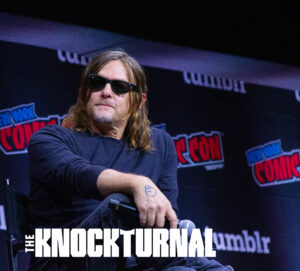Julian Cannon
Julian Cannon
Julian Cannon is a seasoned entertainment editor with a keen eye for capturing the pulse of the industry. With a career spanning over a decade, he has become a trusted voice in the realm of TV, movies, events, conventions, and red carpets. Julian's expertise lies in delivering insightful commentary on the latest trends, exclusive interviews with industry luminaries, and comprehensive coverage of high-profile events. Twitter: @Julianexcalibur Instagram: @Julianexcalibur Contact: Julian.theknockturnal@gmail.com
In this week’s episode of Fear The Walking Dead, we see it is Charlie’s last episode. But before that, Madison, Strand, and the rest are on a fetch quest.
Inside a store, their paths cross with members of PADRE who are in the process of securing valuable gas supplies. Amidst the search, Madison believes she spots a walker who closely resembles her daughter, Alicia. This prompts a reunion with Luciana, highlighting the bond between these characters.
Madison, who has endured immense loss, becomes determined to put the Alicia to rest and move forward if she sees her as a walker. The group then learns that Luciana’s gas station is, in fact, an outpost and their supplies are sourced from PADRE’s containers. The ever-present tension escalates when Madison encounters Charlie, only for her to discover that she was the one responsible for her son Nick’s death.
This revelation sparks an emotionally charged confrontation between Madison and Charlie. The exceptional acting performances by Kim Dickens and Alexa Nisenson provide depth to the grief-stricken mother and remorseful Charlie. Their intense argument delves into the complexity of their relationship, with Madison grappling with her desire for revenge, while Charlie contends with the weight of her actions.
However, it is important to point out that the decision to have such a confrontational scene, followed by Charlie taking her own life later in the same episode, leaves a lingering sense of inconsistency and lack of closure. After being treated for radiation poisoning at PADRE, Charlie was living with Luciana and dedicated herself to a mission that spanned several years to expand a trade network. Although it was good to know this information, it is more of a tell, but do not show. But then again, there are only a few more episodes left for this season so there is not enough time to tell that story (which it should have been given more time).
Madison’s line of “why is she still here” about Charlie echoes the sentiments of the Walking Dead community, as they question the continued existence of her for all these years. Strand’s response, emphasizing second chances, means nothing to me, to be honest.
Daniel’s is too humanized and this element, and’t resonate well with some viewers, who find it difficult to suspend their disbelief in light of his past threats.
The culmination of the episode sees a predictable and somewhat repetitive confrontation between Troy and Madison’s group, characterized by the usual standoffs and prolonged discussions. This approach feels overly familiar and cannot deliver a fresh dynamic in the narrative.
In conclusion, this episode of Fear The Walking Dead is rather mid, offering limited substance to the overall storyline. The exceptional acting by Alexa Nisenson stands out as a highlight, although it feels as if characters are required to channel their full acting prowess only in their final episodes, rather than throughout the series.










